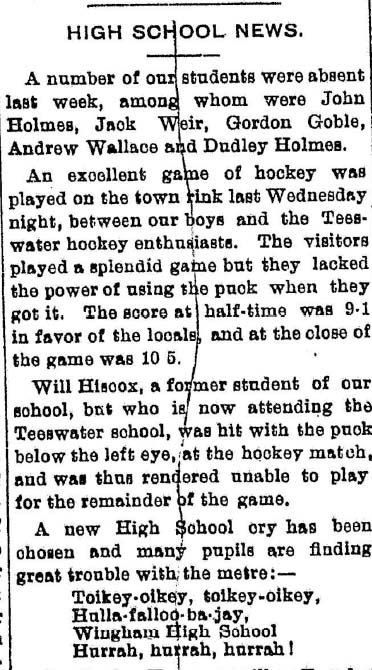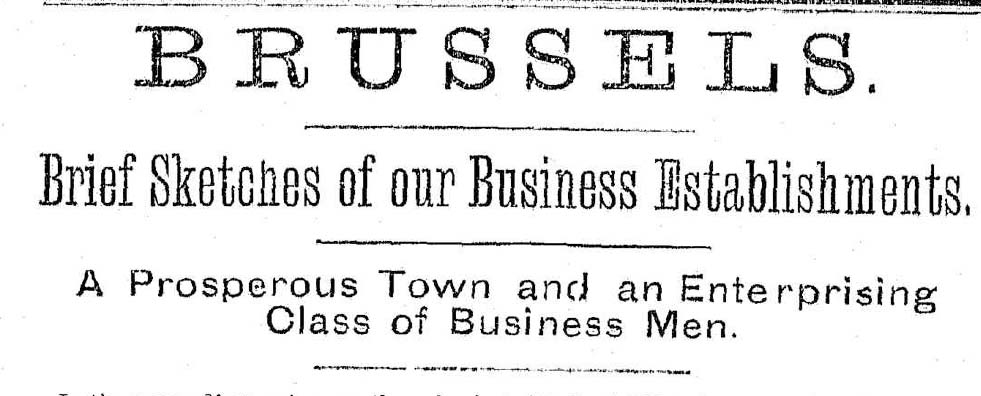Kyle Pritchard, Special Project Coordinator for Huron’s digitized newspaper project, examines the types of content newspapers produced and how it changed over time to reflect the needs and demands of a growing community. You can search the newspapers yourself for free at https://www.huroncountymuseum.ca/digitized-newspapers/
In the age before smartphones and flat screens, newspapers served an important role in the functioning of communities. The Huron County Digitized Newspaper Collection began as Project Silas in 2014 to improve access to the enormous volume of local newspaper content previously only available on microfilm and in their physical format. Today, the digitized collection holds over 350,000 newspaper pages, which preserves a century and a half of local history. The papers were scanned and made searchable using OCR (optical character recognition) technology to assist researchers of all kinds to advance our understanding of the history of Huron County. Each of the newspapers in the digitized collection captures a unique vantage point of the past and is an invaluable tool for researchers in topics as wide-ranging as political, social, cultural and genealogical history.
Many newspapers have come and gone from Huron County, and only a handful have modern counterparts which have survived until today. Many publishers shut down, relocated, or merged with other news agencies to stay afloat. Those that lasted did so by pivoting to new audiences and revenue streams to keep the presses printing. By doing so, editors expanded the roster of sections their newspapers offered to retain their relevance and competitiveness.

High School News published in the Wingham Times, Feb. 11, 1909.
Local newspapers strove to build a sense of communal identity. Farmers and merchants relied on newspapers extensively for everything from rural news, to exhibition schedules, to weather forecasts. Business was so central to early newspapers that a review of local businessmen and their storefronts in the Brussels Post in 1893 filled the entire front page. (Brussels Post, Oct. 20, 1893, pg. 1). The personals column documented locals’ travel arrangements in and out of the county and informed them of visitors returning home. A defense of personals columns was reprinted in the Clinton News Record from the Listowel Banner after the editor received complaints that “they are silly and that they are not read.” They responded by referring to the personals in their own paper as being “one of the most interesting developments in modern journalism,” (Clinton News Record, Aug. 8, 1935, pg. 3).
By the turn of the 20th century, sections on politics, business and industry within newspapers were condensed to increase the space available for larger advertisements and new columns. This trend increased as newspaper readership grew more slowly over the course of the world wars with competition from radio and television. In response, editors endeavored to expand the reach of their newspapers to new audiences. Fashion, recipe and lifestyle sections were introduced in hopes of appealing to women, and cartoons and high school news were aimed at stimulating the interest and involvement of young people. Readers who perused The Seaforth News in 1962 could discover the new culinary marvel of pancake houses which were taking the United States by storm and try their hand at “African banana pancakes” and “New Orleans kabob hot cakes”. (The Seaforth News, March 22, 1962, pg. 2) Or, depending on the decade, they might serve their families an unsavory recipe for depression-era oyster stuffing. (The Wingham Advance-Times, Dec. 19, 1935, pg. 7) Just like readers in the past, these kinds of recipes are preserved today in the digitized newspapers just waiting for savvy or unsuspecting chefs to test them out in their own kitchens.
Newspapers were also an important medium for local teens to keep a record of events, communicate, and share high school gossip. Yet, it might be surprising to know that the oldest high school news column in Huron County started in 1909 in the Wingham Times. It was not really until after the Second World War that young people really established a presence in news reporting. (Wingham Times, Feb. 11, 1909, pg. 1) Introduced to fill some of the space left by wartime commentary, high school journalism was forward-thinking and allowed the opportunity for newspapers to attract and engage with a younger audience. The results of games played by local sports teams and club activities were a major highlight of these sections, which eventually came to fill a whole sheet in the newspaper. (Lucknow Sentinel, Dec. 18, 1947, pg. 3)
Even small editorial changes which found room for community announcements, movie showtimes, advice columns and crossword puzzles were intended to position local news so that papers provided little bouts of day-to-day wisdom, small-town gossip and casual distraction. In an October edition of the Exeter Times-Advocate published in 1969, readers were treated to a horrorscope, an inverted horoscope which only offered bad advice. Pisces were told that “Long trips are not advised today. Neither are short trips. It might be well to stay in the house. Try not to think,” whereas Capricorns were reminded it was “A good day to pay off your bills, if you only had the money. Be thankful you have a roof over your head,” (Exeter Times-Advocate, Oct. 23, 1969, pg. 9)
The Digitized Newspaper collection is constantly expanding to include more local historical content. The database is free, searchable and easy to use. So, what are you waiting for? Whether a traditional, or not so traditional, recipe, a photograph of your high school sports team, or the latest in 1970s fashion, head on over to the Huron County Museum website and start exploring! Who knows what you might find?


